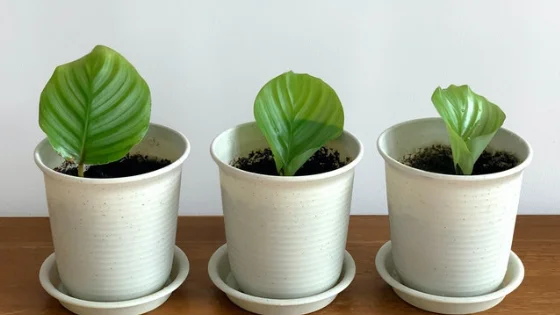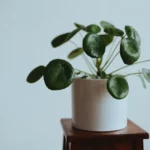Table of Contents
Caring for Calathea Orbifolia
Calathea Orbifolia, sometimes called Goeppertia orbifolia, is a prayer plant that originated in Bolivia. It’s highly sought after as a houseplant in more temperate climates.
Calathea orbifolia has large leaves that grow up to a foot across under good conditions. It has beautifully patterned green and silver leaves that attract attention, and at night, the leaves fold upward as if in prayer.
It isn’t the easiest tropical houseplant to keep alive, but it’s generally worth it for its striking beauty, so it tends to be in high demand.
Helping Calathea Orbifolia Thrive
Calathea orbifolia can be fairly sensitive to its environment, but all it needs is the right balance of conditions in order to thrive.
This plant needs medium to high humidity, low to medium light, and moist soil that doesn’t stay too wet. In exchange, you’ll be rewarded with a happy, dramatic houseplant with a personality as big as its leaves.
Calathea orbifolia doesn’t need to be pruned regularly and doesn’t care for being moved or repotted, so in some respects, it’s actually easier than other plants.
Watch for brown or yellow on the leaves, and keep an eye out for curling or wilting leaves. All of these are indicators that something isn’t quite right with the plant’s environment.
Light Requirements
Calathea orbifolia is natively a plant that grows very near the ground, surrounded by larger plants. As a result, it does best in medium, diffuse light or shade.
It can do well in a little lower light, too, but try to make sure that it has at least enough light for you to comfortably read by. Less light than that and the plant may lose its patterning or cease to thrive.
Be careful not to put Calathea orbifolia in too bright or direct lighting. It is prone to scorching and sensitive to too much light.
Temperature Requirements
Calathea orbifolia does well in fairly standard indoor temperatures, preferring 65 to 75 degrees Fahrenheit.
It can tolerate a little warmer or a little cooler, but if it gets much below 60 degrees, it can die quickly. It won’t grow as quickly at the lower ends of this temperature range.
If the leaves start browning or curling, check both temperature and light levels.
Soil Requirements
Like a lot of tropical houseplants, Calathea orbifolia does best with a well-draining soil. It’s important to make sure the pot allows for drainage.
Calathea orbifolia is a little more sensitive than most to the specific moisture level, so a mix of peat and perlite is a good idea.
It retains enough moisture for the plant to get water, but not enough moisture to keep the roots actively wet, which would lead to root rot.
Humidity Requirements
Calathea orbifolia does best in medium or high humidity. If you live in a dry climate, it’s probably a good idea to invest in a humidifier.
If it’s only a little dry, you can keep plants nearby each other for watering, or you can place plates or bowls with a bit of water nearby to increase the ambient humidity.
How to Water Calathea Orbifolia
Calathea orbifolia should be watered about once a week. However, more than a lot of plants, this frequency can vary. Check the top inch or so of soil. If it’s starting to dry out, the plant should be watered.
Like other tropical plants, it’s susceptible to root rot, so it’s important not to overwater Calathea orbifolia. If the leaves start turning yellow, chances are good that it’s getting a little too much water or not draining well enough.
Additionally, Calathea orbifolia is sensitive to the contaminants and additives in unfiltered tap water. It’s a good idea to use filtered water or rainwater.
How to Fertilize Calathea Orbifolia
Because Calathea orbifolia doesn’t handle mineral buildup very well, it only needs fertilizer once a month from spring through fall, and the fertilizer should be diluted to about 1/4 normal strength.
Pruning Calathea Orbifolia
Calathea orbifolia is a plant that grows a single leaf from each stem. As a result, it really doesn’t need pruning unless something is wrong. It’s okay to go ahead and trim browned or dead leaves, but leaves in good condition should generally be left alone.
Propagation of Calathea Orbifolia
Propagation of Calathea orbifolia isn’t too complicated in theory, as long as you have a gentle hand and a bit of patience.
However, before you get started, keep in mind that this plant doesn’t care to be disturbed, so there is a chance of a healthy plant ceasing to thrive after an attempt at propagation.
To make more Calathea orbifolia, carefully remove the plant from its pot. You should see the natural divisions between stems.
Very carefully separate the plant at one of these divisions, easing roots apart rather than tearing them. Then, re-plant both parts in separate pots.
The plant may be in a bit of distress for up to a few weeks. Pay extra attention to its soil moisture and humidity levels until it has a chance to recover.
Extra tips for Calathea Orbifolia Care
Pests and Diseases
Like most tropical houseplants, Calathea orbifolia is prone to root rot, which can be avoided by not overwatering the plant and not allowing water to sit against the roots.
Ridding Calathea Orbifolia of Fungus or Mildew
If you see white patches on the leaves, wash them gently with a damp cloth, being sure not to leave any water resting on the leaves. You may then apply neem oil, especially if this is a recurring problem.
Ridding Calathea Orbifolia of Pests
Because Calathea orbifolia has such large leaves, it does attract pests that like to hide under the leaves. You can check the undersides of the leaves at night when it has its leaves up, or you can gently move them during the day.
If you see signs of infestation, manually remove any pests, eggs, or webs. Then wipe down the plant and apply a gentle insecticide or neem oil.
If you see any thrips, it’s a good idea to all change out the topsoil where that particular insect lays tiny eggs.
Toxicity
Calathea Orbifolia is non-toxic and safe to keep around pets and small children.
Quick Reference
- Light: Medium, indirect or diffuse
- Temperature: 65 to 75 degrees Fahrenheit
- Soil: Mix of peat/perlite
- Humidity: 50% or higher
- Water: As needed when top soil is starting to dry
- Pruning: Dead or dying leaves only



